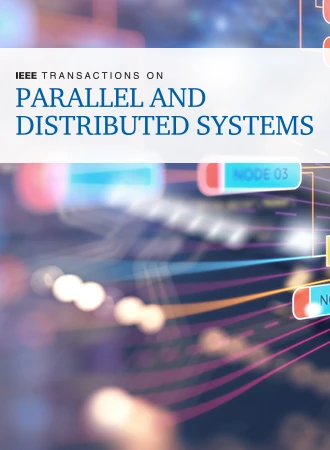HybRAID: A High-Performance Hybrid RAID Storage Architecture for Write-Intensive Applications in All-Flash Storage Systems
IF 5.6
2区 计算机科学
Q1 COMPUTER SCIENCE, THEORY & METHODS
IEEE Transactions on Parallel and Distributed Systems
Pub Date : 2024-07-19
DOI:10.1109/TPDS.2024.3429336
引用次数: 0
Abstract
With the ever-increasing demand for higher I/O performance and reliability in data-intensive applications,HybRAID:面向全闪存存储系统中写入密集型应用的高性能混合 RAID 存储架构
随着数据密集型应用对更高 I/O 性能和可靠性的需求不断增长,通常配置为独立磁盘冗余阵列(RAID)的固态硬盘(SSD)被广泛应用于企业全闪存存储系统。镜像 RAID 可在随机存取工作负载中提供更高的性能,而基于奇偶校验的 RAID(如 RAID5)可在顺序访问中提供更高的性能,同时降低成本开销。以往的研究试图通过提供各种方案(包括缓存或记录小写入)来解决基于奇偶校验的 RAID 在小写入(即向单个磁盘写入)方面性能较差的问题。然而,这些技术会带来巨大的性能和/或可靠性开销,在业界很少使用。此外,我们的实证分析表明,部分磁条写入(即写入基于奇偶校验的 RAID 中完整磁盘阵列的一小部分)会显著降低 I/O 性能,而这在以前的工作中还没有得到解决。在本文中,我们首先进行了一项实证研究,结果表明部分磁条写入与全磁条写入(即写入整个磁盘)相比,会降低基于奇偶校验的 RAID 性能达 6.85 倍。然后,我们提出了一种名为 HybRAID 的高性能混合 RAID 存储架构,该架构针对写密集型应用进行了优化。HybRAID 利用基于镜像和奇偶校验的 RAID 的优势来提高写入性能。HybRAID 将 a) 对齐的全磁条写入引导到基于奇偶校验的 RAID 层,将 b) 小/部分磁条写入引导到 RAID1 层。我们提出了一种在线迁移方案,旨在根据更新的访问频率,将基于奇偶校验的 RAID 中的小规模/部分写入转移到 RAID1。作为补充,我们进一步提供了离线迁移,其目的是在快速层中腾出空间,以备将来参考。在企业固态硬盘上的实验结果表明,与基于奇偶校验的 RAID 和 RAID10 相比,在同等成本下,HybRAID 将写密集型应用的性能分别提高了 3.3 倍和 2.6 倍,单位成本性能分别提高了 3.1 倍和 3.0 倍。
本文章由计算机程序翻译,如有差异,请以英文原文为准。
求助全文
约1分钟内获得全文
求助全文
来源期刊

IEEE Transactions on Parallel and Distributed Systems
工程技术-工程:电子与电气
CiteScore
11.00
自引率
9.40%
发文量
281
审稿时长
5.6 months
期刊介绍:
IEEE Transactions on Parallel and Distributed Systems (TPDS) is published monthly. It publishes a range of papers, comments on previously published papers, and survey articles that deal with the parallel and distributed systems research areas of current importance to our readers. Particular areas of interest include, but are not limited to:
a) Parallel and distributed algorithms, focusing on topics such as: models of computation; numerical, combinatorial, and data-intensive parallel algorithms, scalability of algorithms and data structures for parallel and distributed systems, communication and synchronization protocols, network algorithms, scheduling, and load balancing.
b) Applications of parallel and distributed computing, including computational and data-enabled science and engineering, big data applications, parallel crowd sourcing, large-scale social network analysis, management of big data, cloud and grid computing, scientific and biomedical applications, mobile computing, and cyber-physical systems.
c) Parallel and distributed architectures, including architectures for instruction-level and thread-level parallelism; design, analysis, implementation, fault resilience and performance measurements of multiple-processor systems; multicore processors, heterogeneous many-core systems; petascale and exascale systems designs; novel big data architectures; special purpose architectures, including graphics processors, signal processors, network processors, media accelerators, and other special purpose processors and accelerators; impact of technology on architecture; network and interconnect architectures; parallel I/O and storage systems; architecture of the memory hierarchy; power-efficient and green computing architectures; dependable architectures; and performance modeling and evaluation.
d) Parallel and distributed software, including parallel and multicore programming languages and compilers, runtime systems, operating systems, Internet computing and web services, resource management including green computing, middleware for grids, clouds, and data centers, libraries, performance modeling and evaluation, parallel programming paradigms, and programming environments and tools.
 求助内容:
求助内容: 应助结果提醒方式:
应助结果提醒方式:


